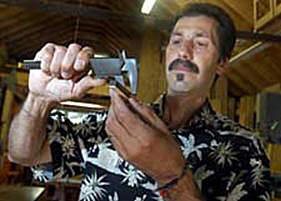|
|

|
Music man: Classic clavichords crafted in
Canton

Charles Wolff measures a key for a clavichord he
is building in his shop in a late 19th century
carriage house next to his home. (LISA BUL/The
Patriot Ledger)
|
By ROBERT SEARS
The Patriot Ledger
CANTON - With its table saw, belt sander and other power
tools, Charles Wolff’s home workshop can be pretty
noisy, but the end result will be music to a demanding
musician’s ears.
The shop in a late 19th century carriage house next to
his home is dedicated to building one of the piano’s
early relatives, the clavichord.
It’s a somewhat unusual craft for a Nyack College piano
performance major whose woodworking experience was
limited to building a deck with his dad.
But Wolff made the switch from playing to building
keyboard instruments when he arrived in
Boston
in 1978 just in time for the blizzard and got an
internship with the noted builder of harpsichords, Carl
Fudge.
‘‘That was when I realized I wasn’t going to be a
concert pianist, and I thought, well, this is
interesting, I’ve always liked harpsichords,’’ he said.
Wolff honed his woodworking skills building harpsichords
and clavichords and do-it-yourself kits with Fudge for
10 years.
‘‘A Carl Fudge kit was a pretty big deal,’’ he said.
When Fudge retired, Wolff took over the business.
These days Wolff mainly builds clavichords. There have
been years he produced from 10 to 20 fully built and kit
versions, but he says the business is cyclical.
A large, completely built clavichord can cost $15,000 to
$20,000. Kits range from a few thousand to $6,000.
Wolff’s customers include professional musicians,
amateur players, and music schools.
‘‘There are a lot of amateur players, some great ones,’’
he said.
For a time, his clavichords were exact copies of
original 18th century instruments, but these days he’s
tweaking the designs to his own standards. ‘‘I thought I
needed a change,’’ he said.
His clavichords are not radically different, and changes
are mostly invisible to the casual observer. They can
involve the keyboards, the positioning of the bridge and
the way the cabinets are braced, for example.
‘‘That’s heresy to some people, but I’ve built so many,
and you learn from what you’ve done. The older builders
did the same thing,’’ Wolff said.
‘‘The clavichord is basically a very simple instrument.
The main components are the keys, the strings, the case,
which contains the soundboard and the bridge. The bridge
and soundboard are probably the most important parts,’’
he said.
Wolff likes Sitka spruce for soundboards, both for its
color and ‘‘great tonal qualities.’’ Bridges are usually
made of beech but can be maple. Structural members are
mostly pine or poplar.
The case of his most recent clavichord is cherry wood
with inlaid mother of pearl and ebony. The keyboard is
basswood. The black keys are ebony; the white keys are
bone, since the use of ivory is outlawed in the United
Sates.
Wolff strings his instruments with special hand-drawn
wires from
England. ‘‘It’s beautiful stuff. The sound is just
unbelievable,’’ he said.
A ‘‘good touch’’ is a hallmark of a well-built
clavichord. Its mechanism should be smooth and quiet
without rattles.
‘‘A clavichord with good touch is sensitive, reacts
quick, returns really fast - you can play really fast on
these things. You want something that really feels good
that doesn’t get in the way of your playing,’’ Wolff
said.
‘‘What’s great about the clavichord is that it gives you
direct contact with the strings. It’s sort of like a
guitar, you can bend the string and get different sounds
that way, and it’s a really sensitive instrument. It
really teaches you to use proper technique. You can’t
play sloppy; it just won’t sound right,’’ Wolff said.
He has built several of the rarest type clavichords that
are played with foot pedals. They are played in
conjunction with one or two hand-played clavichords,
kind of like an organ.
‘‘I’ve probably built more than anyone in the U.S. -
four of them,’’ Wolff said.
‘‘The last one I built was my own design. I took a
historic model and turned it inside out and around so
that it would work the way I wanted it to work,’’ Wolff
said.
Recently Wolff has been designing changes he believes
will greatly improve upon the clavichords built by the
old masters.
‘‘I want to make one that will be different in response
and touch. It will look a little different because I’ll
have to move things around,’’ he said.
‘‘I’ve been brainstorming, throwing things on paper. It
looks good. It looks easy, then you start doing the math
and you realize why clavichords have looked the way they
do for 300 years,’’ he said.
Copyright 2007 The Patriot Ledger
Saturday, September 29, 2007
|
|
|

